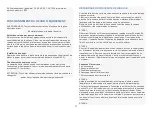
7
STARTING THE SANDING PROCESS
Before operating the machine, make sure the handle adjusting lever is tight.
Empty the vacuum system when full into a metal canister away from your
workspace and other
Flammable materials (this may need done several times during the
process).
Remove the vacuum system from the unit when not in use and empty
contents as instructed above.
STEP 1:
Determine the condition of the floor. We recommend staring with
36 grit (24 grit for severely damaged or heavy polyurethane
floors). Lean the machine back on its handle. Attach the
sandpaper to the backer pads. Sandpaper usage will
depend on the finish to remove, and the amount of wood
that needs to be removed.
STEP 2:
With the U-Sand® equipment in the upright position, turn the
switch on and slowly move the sander over the floor, letting
the machine do the work for you. For new installation it is
recommended to move the machine across the grain, this is
the most effective way to level the floor. (change
Sandpaper when it appears plugged or dull).
Proper Grit Sequence:
24 if needed
36 for leveling
40 sand thoroughly
80 final sanding and clear finish
120 recommended for staining
STEP 3:
After sanding the floor completely, with the first grit, vacuum the floor
thoroughly and change paper to the next finer grit. Continue the sanding
process. Check paper after sanding about a 10’ x 10’ area to see that the
paper is still sanding. Inspect the floor to see if any swirl marks remain. If
swirl marks exist, continue to sand just the area with the higher grit paper
until they are less visible. You should get down close to the floor and view
it from several directions in good light for this inspection.
STEP 4:
Use progressively higher grits. Sand the floor completely. This step will take
less time than the previous grits. Check sandpaper often to make sure it is
clean and effective.
STEP 5:
Inspect the floor thoroughly for scratches or unevenness. Apply the final
finishing grit (usually 120 or 180 grit). At this point, the floor should
become smooth and free of all swirl marks when inspected closely.
STEP 6:
Corners and edges and be sanded with a detail sander or hand scraper. A
paint scraper can be used for hard to reach areas, such as: under radiators,
and in corners. Some hand sanding may be necessary in these remove
places. Inspect the floor thoroughly to determine when you are finished
sanding.
STEP 7:
Vacuum the floor and clean with a tack cloth (available at your local
hardware store). Then apply stain or varnish as desired. Follow
manufacturer’s recommendations for staining and finishing.
STEP 8:
WARNING: Machines can cause Flammable materials and vapors to burn. Do not
use this machine with or near matches, fuels, grain dust, solvents, thinners, or
other flammable materials.
WARNING: To prevent injury always remove the electrical plug from the electrical
outlet before changing the
Sandpaper, emptying the bag, leaving the machine, or doing any maintenance to
this machine.








































